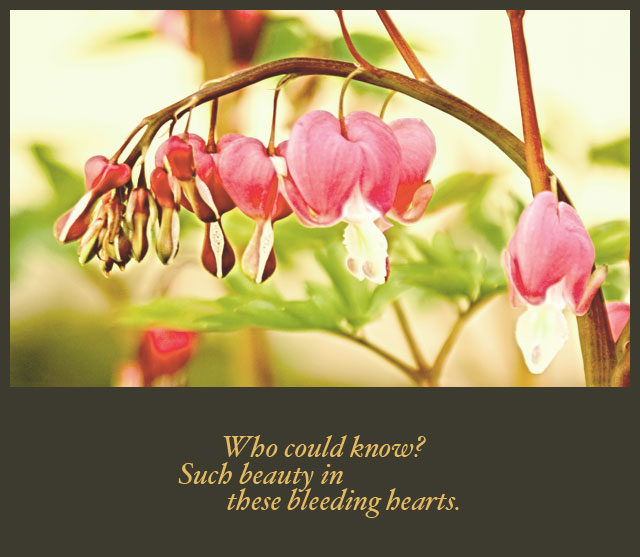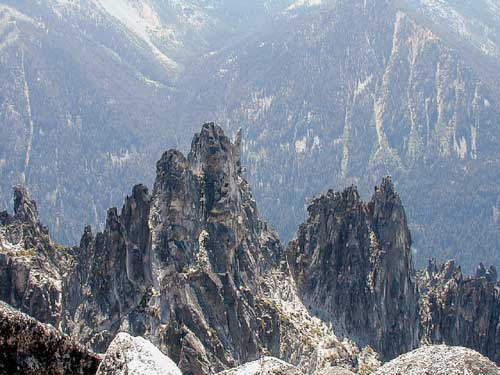
Bleeding Hearts


After reading the shorter travel diaries, I really think translator Sam Hamill would have been wiser to have presented them before Narrow Road to the Interior because, despite some excellent haiku, they came as somewhat of disappointment, though they might have seemed more innovative and stimulating if they had been presented before Basho’s masterpiece. To make matters worse, the second best work Travelogue of Weather Beaten Bones is presented second, and the other two journals drop off rapidly after that.
The most powerful section in Travelogue of Weather Beaten Bones was also, for me at least, a most disturbing one:
On the bank of the Fuji River, we came upon an abandoned child, about age two, its sobs stirring our pity. The child’s parents must have been crushed by the waves of this floating world to have left him here beside the rushing river to pass like dew. I thought the harsh autumn winds would surely scatter the bush clover blossoms in the night or wither them ” and him ” in the frosty dew of dawn. I left him what food I could.
![]() Hearing the monkey’s cries “
Hearing the monkey’s cries “
![]() what of the child abandoned
what of the child abandoned
![]() to the autumn wind?
to the autumn wind?
How can this happen? Did his father despise him? Did his mother neglect him? I think not. This must be the will of heaven. We mourn his fate.
I’d like to think that we live in a very different time and under very different conditions. But even now reading these words is painful, almost too painful. It reminds me that such conditions still exist in other less fortunate parts of the world, and that some people are still faced with painful dilemmas that force them to rationalize their decisions. But, whether or not I live under “the will of heaven,” I’m glad that I don’t have to see the world this way.
The Knapsack Notebook, the second journal, strings together a series of beautiful haiku united by a narrative thread, but I was disappointed that there was little that actually seemed like modern-day haibun.
One of my favorite haiku reminds me of springs I’ve loved on long-trodden hikes:
I saw a beautiful clear stream pouring from a crack in a moss-covered stone:
![]() A fresh spring rain
A fresh spring rain
![]() must have passed through all the leaves
must have passed through all the leaves
![]() to nourish this spring.
to nourish this spring.
Unfortunately, the final journal, Sarashina Travelogue, was a mere four pages long, too short to ever really engage me.

![]() three days climbing
three days climbing
![]() this old heart
this old heart
![]() goes no further.
goes no further.
The Narrow Road to the Interior is a surprisingly short book, barely 30 pages long as translated by Sam Hamill. It’s actually rather hard to write anything meaningful about it because, despite my first assumptions, there is no one pattern to the entries, though many entries consist of a short prose passage followed by a final haiku. Some of the most interesting entries, though, contain multiple haiku written by more than one author, and even entries that contain no haiku seem quite “poetic.”
Any commentary is complicated by the fact that I really can’t think of anything comparable that I have read, though if I were still in college I might be tempted to compare it to Thoreau’s Walden, though Thoreau’s writing is certainly much more discursive. If I had access to some of Emily Dickinson’s letters where she included it poems that I’ve heard mentioned, but not read, it would be interesting to see if they are comparable.
As it is, I am limited to citing two of my favorite passages to indicate the general flavor of this journal, though it is difficult to limit myself to just two citations because this journal contains some of Basho’s most famous haiku.
Personally, I’m fondest of the format where a short prose passage is ended by a haiku. Of those entries, this one may well be my favorite, though I suspect that it is the haiku, more than the prose entry that I love:
In Yamagata Province, the ancient temple founded by Jikaku Daishi in 86o, Ryushaku Temple is stone quiet, perfectly tidy. Everyone told us to see it. It meant a few miles extra, doubling back toward Obanazawa to find shelter. Monks at the foot of the mountain offered rooms, then we climbed the ridge to the temple, scrambling up through ancient gnarled pine and oak, gray smooth stones and moss. The temple doors, built on rocks, were bolted. I crawled among boulders to make my bows at shrines. The silence was profound. I sat, feeling my heart begin to open.
![]() Lonely stillness-
Lonely stillness-
![]() a single cicada’s cry
a single cicada’s cry
![]() sinking into stone
sinking into stone
It’s hard to decide whether the last prose lines, “The silence was profound. I sat, feeling my heart begin to open.” or the beautiful haiku is more poetic. Both seem profoundly true to me.
What may well be my favorite prose entry contains no haiku at all:
We paid homage at Gongen Shrine on the fifth. The first shrine on the mountain, it was built by Nojo, no one knows exactly when, The Engi Ceremonies calls it Ushusato Mountain, Feather Province Village Mountain, but calligraphers’ errors got it changed to Feather Black Mountain, The province is called Dewa, Feather Tribute, dating from an eighth-century custom whereby feather down from this region was used as payment of tribute. Together with Moon Mountain and Bath Mountain, Feather Black Mountain completes the Dewa Sanzan, or Three Holy Mountains of Dewa. This temple is Tendai sect, like the one in Edo on Toei Hill. Both follow the doctrine of shikaxaztz, ‘deep-sitting concentration and insight,” a way of enlightenment as transparent as moonlight, its light infinitely increasing, spreading from hermitage to mountaintop and back, reverence and compassion shining in everything it touches. Its blessing flows down from these mountains, enriching all our lives.
One wonders whether Basho, as I do, felt that the final lines of this entry were so poetic that it would have been redundant to include a final haiku.
If I had been exposed to this journal earlier in my life, I would have been sorely tempted to use this technique to record week-long hikes I’ve spent in the mountains. As it is, I will continue practice writing haiku, and occasionally slipping them into my blog entries in hopes that I can continue to develop my skills as a writer.
Thinking back, at one point in my retirement, I’d hoped to use a technique very like this to create a hiking weblog with a friend. Certainly my week-long hike in the North Cascades with the Sierra Club, accompanied by delightful companions from throughout the world, would have provided some great material for such an effort.